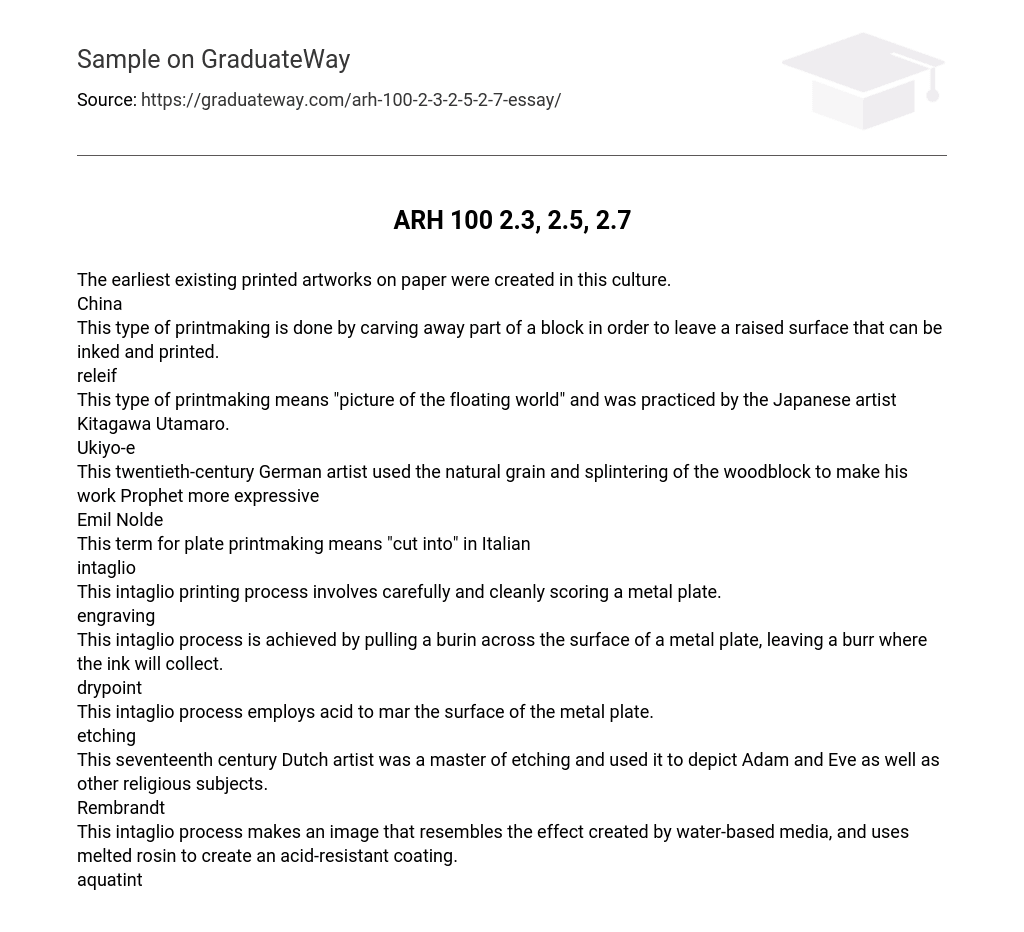The earliest existing printed artworks on paper were created in this culture.
China
This type of printmaking is done by carving away part of a block in order to leave a raised surface that can be inked and printed.
releif
This type of printmaking means “picture of the floating world” and was practiced by the Japanese artist Kitagawa Utamaro.
Ukiyo-e
This twentieth-century German artist used the natural grain and splintering of the woodblock to make his work Prophet more expressive
Emil Nolde
This term for plate printmaking means “cut into” in Italian
intaglio
This intaglio printing process involves carefully and cleanly scoring a metal plate.
engraving
This intaglio process is achieved by pulling a burin across the surface of a metal plate, leaving a burr where the ink will collect.
drypoint
This intaglio process employs acid to mar the surface of the metal plate.
etching
This seventeenth century Dutch artist was a master of etching and used it to depict Adam and Eve as well as other religious subjects.
Rembrandt
This intaglio process makes an image that resembles the effect created by water-based media, and uses melted rosin to create an acid-resistant coating.
aquatint
This intaglio process is achieved by roughening the entire metal plate surface with a rocking tool then smoothing the areas where the ink is to be wiped away.
mezzotint
This type of prinktmaking does not a require the artist to cute into the surface, the ink is suspended by other means to complete the print.
Planographic
In one of his lithographic images, this French artist depicted the aftermath of an incident of police brutality.
Honore duamier
This printmaking process is used for t-shirts solar panels and circuit boards .
silkscreen
A group of tints that are identical and produced in a limited number is called ______.
an edition
This process can be used to create a unique printed image, and involves a clean plate of metal or glass on which the artist carefully inks the image then prints.
monotype
When were the first successful photographs made using a camera?
early 1800’s
The first cameras were ________.
room sized
What does the word “photograph” mean
Writing with light
The name of the opening that lets light into any camera is called ________.
aperture
Daguerreotypes are made on ________
polished metal plates
A major benefit of the calotype process is that ______
calotypes are negatives that can be readily reproduced
The American photographer Edward Weston focused closely on the subject of his Pepper No. 30, making the viewer concentrate on the ______ and ______ of the vegatable.
form . . . texture
Hannah Höch was part of a movement known as _______.
Dada
Sally Mann’s 1989 photograph The New Mothers was made _______.
in black and white
Shining a light through a film negative reverses the tones, True or False.
True
Artworks made using alternative media and processes _______.
all of the previous answers
Jackson Pollock is known for:
splashing, pouring, and dripping paint onto a canvas as he walked around it on the floor.
Artworks made by using alternative media are best accessed by
direct experience . . . visual documentation or personal accounts.
Composer John Cage’s Theater Piece No. 1
the performance itself and discussions of it
In Joseph Beuys Coyote, I Like America and America Likes Me, the artist:
wrapped himself in felt and lived for five days alone in an art gallery with a coyote
Vito Acconci is the artist who created ______.
Following Piece
The work of ______ was directly influential on the conceptual art movement.
Marcel Duchamp
Barbara Kruger’s Untitled (Your Gaze Hits the Side of My Face):
employes her background as a graphic designer in its use of text and image.
What unconventional material does Bruce Nauman use in the True Artist Helps the World by Revealing Mystic Truths (Window or Wall Sign)?
neon tubing
Mel Chin’s Fundred Dollar Bill Project is designed to:
raise awareness about and campaign for the treatment of lead-toxic soil.
Kara Walker’s installation Insurrection! (Our Tools were Rudimentary, Yet We Pressed On) combines:
silhouette drawings and projections
emphasizes the ideas behind an artwork over any material production to represent those ideas
conceptual art
impromptu art actions, initiated and planned by an artist, the outcome is not known in the end
happenings
artworks that track the movements and gestures the artist makes during their production
action paintings
artworks that transform a space
installations
an art action or event that incorporates elements of music, dance, poetry, video, and multimedia
performance art
Remember! This essay was written by a student
You can get a custom paper by one of our expert writers
Order custom paper
Without paying upfront

